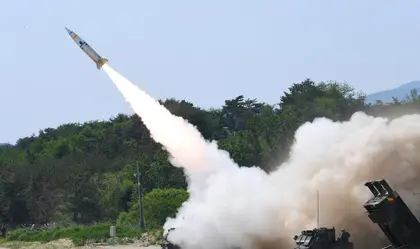Russian officials have claimed its integrated and modern air defense networks deployed to Ukraine’s Luhansk region recently scored an unprecedented double kill of a pair of American ATACMS ballistic missiles.
It sounded good on Wednesday but by Friday that story had problems.
JOIN US ON TELEGRAM
Follow our coverage of the war on the @Kyivpost_official.
Russian state-controlled media platforms on Oct. 25 reported the engagement took place in Ukraine’s eastern Luhansk region and that two or three incoming US-made ATACMS missiles were destroyed by Russian air defense units in the area.
The ATACMS is a ballistic missile flying in a high, parabolic trajectory at hypersonic speeds. Russia according to open sources and its own statements operates only one air defense system advertised as capable of intercepting an incoming ballistic missile, the S-400 Trimuf (NATO descriptor: SA-21 GROWLER). Russian official reports did not identify the weapon purportedly used to shoot down the ATACMS missiles.
Video geolocated to a rural airfield on the north-east outskirts of Bilorechinsky village, in the south of Luhansk region, showed billowing smoke from a ground fire and chains of explosions. A voice over said the chaos was the result of a Ukrainian military strike using a weapon arriving by air.
VIDEO of explosions in Bilorichens'kyi, occupied Luhansk region after it was hit by Ukrainian strikes. #Ukraine #Ukrainewar #ukraineRussiawar #Russia pic.twitter.com/P228m1GNAr
— raging545 (@raging545) October 25, 2023
Local residents found debris of two ATACMS first stages in the area, one on the grounds of an industrial site. Photographs first made public by Russian state-controlled news platforms and quickly recirculated on social media showed one ATACMS section lying on its side and the other stuck in the ground.

South Korea Demands 'Immediate Withdrawal' of North Korean Troops in Russia
The Kremlin-sponsored “war correspondent” Vladimir Rogov in a Wednesday blog typical of Russian euphoria over the purported shoot downs cheered “Russian Defense Ministry – First two shot down ATACMS. Yet another wunderwaffe (Nazi wonder weapon) has turned into a wonder waffle. Ukrainian victory once again turned out to be a betrayal.”
Claims like Rogov’s triggered objections on both sides of the fighting lines. Yury Ihnat, Ukrainian Air Force spokesperson, in Oct. 26 comments to media said “There needs to be proof. If someone took a picture of an ATACMS engine, that doesn’t mean, that they shot it down.”
Both the Ukrainian and Russian armies operate anti-aircraft systems theoretically capable of intercepting a ballistic missile like an ATACMS, but actually hitting it is extremely difficult, Ihnat said.
US-delivered Patriot missiles on May 4 hit and destroyed in air space over the Ukrainian capital Kyiv at least two Russian air-dropped Kinzhal missiles, a ballistic weapon claimed by the Kremlin to be impossible to intercept because of its hyper-sonic speed.
Russian state-controlled media reported the semi-ballistic Kinzhal struck and destroyed a Patriot missile battery, a claim widely rejected by official Ukrainian sources and independent observers, among them Kyiv Post reporters.
Pro-Russian military information channels also challenged the Moscow line Kremlin weaponry defeated incoming ATACMS in air space over Luhansk region.
VChK-OPGU, a Telegram platform focusing on Russian army operations in Ukraine, wrote with irony: “Everything was just like the Defense Ministry said. Two ATACMS missiles were destroyed as a result of their making direct hits on positions of units from the Air Defenses of the Russian Federation’s Armed Forces in Luhansk region. The price was three S-400 systems located there.”
According to the report, the ATACMS functioned as designed and scattered hundreds of cluster munitions above multiple Russian anti-aircraft systems.
The falling explosive bomblets saturated an area more than a kilometer square in size, and the missile engines found by search crews in the middle of the impact area weren’t shot down, they just struck the ground by intertia, after firing off their cluster munitions as designed, the report said.
Kriminal-Dossier, an information platform purportedly authored by “a member of one of Russia’s intelligence services”, on Oct. 27 reported that Ukrainian commanders fired three ATACMS missiles at Russian air defense systems in Luhansk region, that Russian air defenses managed to shoot down one of the weapons, but cluster munitions dropped by the other two struck and destroyed three Russian anti-aircraft missile systems. According to unconfirmed reports, two of the systems were launchers.
The Kriminal-Dossier report said that the remains of a pair of ATACMS missile engines lying on the ground of an impact area was much more likely to be evidence that the American weapons functioned normally and hit what they were aimed at, than proof Russian air defenders had - almost miraculously - shot down a US-made ballistic missile.
The Wednesday strikes near the Luhansk region town Belorichensky hit some 95-100 km. from the nearest Ukrainian government-controlled territory suitable for a ATACMS missile launch.
Ukraine since summer 2022 has received and used – at times with devastating effect -the US-produced M30 precision-guided rocket launched from the HIMARS and M270 fire systems. The M30 as used by the Armed Forces of Ukraine (AFU) has had a maximum effective range of 85 km.
Both HIMARS, a truck-mounted rocket launcher, and M270, an armored vehicle carrying a rocket launcher on tracks, are designed by the major US arms manufacturer Lockheed Martin to fire, besides the M30 rocket, the longer-ranged and more powerful ATACMS missile.
According to open sources, the range of the ATACMS model currently delivered to Ukraine by the US is about 165 km. First deliveries of ATACMS to Ukraine were announced in Sep. 2023 and first battlefield use according to reports was on Oct. 17.
According to news reports, Ukrainian forces fired a total six ATACMS missiles at a pair of Russia-operated air bases, one near the Kherson region city Berdyansk and the other near the city Luhansk. Cluster munitions from the missiles pelted each airfield with as many as 2,700 separate explosive bomblets.
According to conservative estimates later confirmed by satellite imagery, the Russian Air Force lost at least 9 helicopters destroyed (7 Ka-52 attack helicopters and 2 Mi-8 general purpose helicopters) and another 15 helicopters damaged (8 Ka-52 and 7 Mi-8) to the six ATACMS missiles. Moscow says the cost of a single Ka-52 is about $9.1 million and for an Mi-8 about $2.6 million.
It was the largest one-day loss of Russian military aircraft since World War II.
You can also highlight the text and press Ctrl + Enter









